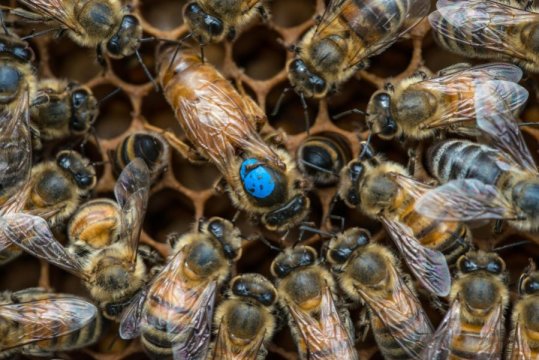[ad_1]
The dramatic difference in gonad size between honey bee queens and their female workers in response to their distinct diets requires the switching on of a specific genetic program, according to a new study publishing March 21 in the open-access journal PLOS Biology by Annika Roth and Martin Beye of Heinrich-Heine University in Dusseldorf and colleagues. The finding is likely to allow more detailed analysis of the interplay of genes and nutrition that drive caste dimorphism in honey bees.
Queen bees differ physically from their sterile sister workers, with a larger body and enlarged ovaries that will produce all the offspring in the hive. Future queens are fed sugar-rich “royal jelly” as larvae, while future workers receive relatively sugar-poor “worker jelly.” But the degree to which diet alone determines the difference in gonadal size between queen and worker has been unclear.
To explore the genetic influences on gonad size, the authors first showed that reduced sugar had no effect on male gonad size, indicating that diet isn’t the sole influence. Next, they used the gene editing tool CRISPR/Cas9 to selectively shut off a gene for general female development — the so-called feminizer gene — in early worker larvae. Unlike traditional genetic screens, this method allowed rapid discovery of the effects of mutation, without the need for multi-generational rearing and crossing. This is the first study in which the gene editing tool has been used to show the effect of mutations in honey bees.
With the feminizer gene turned off, a low-sugar diet had no effect on gonad size, and the gonads were similar to those typically found in male drones. The authors conclude that the feminizer gene must be switched on not only to produce ovaries but also to permit nutrient level to affect gonad size. Further work will be needed to determine if the same gene is sufficient to allow development of large ovaries in future queens, work that will require techniques to exclusively rear queens.
“Because of the ability to rapidly screen mutations in honeybees allowed by gene editing, this study is likely to set the stage for much more extensive investigations of the role of individual genes and gene pathways in immune defense and behavioral and developmental control,” said Beye.
Story Source:
Materials provided by PLOS. Note: Content may be edited for style and length.
[ad_2]















